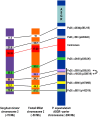In Silico and Fluorescence In Situ Hybridization Mapping Reveals Collinearity between the Pennisetum squamulatum Apomixis Carrier-Chromosome and Chromosome 2 of Sorghum and Foxtail Millet
- PMID: 27031857
- PMCID: PMC4816547
- DOI: 10.1371/journal.pone.0152411
In Silico and Fluorescence In Situ Hybridization Mapping Reveals Collinearity between the Pennisetum squamulatum Apomixis Carrier-Chromosome and Chromosome 2 of Sorghum and Foxtail Millet
Abstract
Apomixis, or clonal propagation through seed, is a trait identified within multiple species of the grass family (Poaceae). The genetic locus controlling apomixis in Pennisetum squamulatum (syn Cenchrus squamulatus) and Cenchrus ciliaris (syn Pennisetum ciliare, buffelgrass) is the apospory-specific genomic region (ASGR). Previously, the ASGR was shown to be highly conserved but inverted in marker order between P. squamulatum and C. ciliaris based on fluorescence in situ hybridization (FISH) and varied in both karyotype and position of the ASGR on the ASGR-carrier chromosome among other apomictic Cenchrus/Pennisetum species. Using in silico transcript mapping and verification of physical positions of some of the transcripts via FISH, we discovered that the ASGR-carrier chromosome from P. squamulatum is collinear with chromosome 2 of foxtail millet and sorghum outside of the ASGR. The in silico ordering of the ASGR-carrier chromosome markers, previously unmapped in P. squamulatum, allowed for the identification of a backcross line with structural changes to the P. squamulatum ASGR-carrier chromosome derived from gamma irradiated pollen.
Conflict of interest statement
Figures


Similar articles
-
Comparative physical mapping of the apospory-specific genomic region in two apomictic grasses: Pennisetum squamulatum and Cenchrus ciliaris.Genetics. 2006 May;173(1):389-400. doi: 10.1534/genetics.105.054429. Epub 2006 Mar 17. Genetics. 2006. PMID: 16547108 Free PMC article.
-
Sequence analysis of bacterial artificial chromosome clones from the apospory-specific genomic region of Pennisetum and Cenchrus.Plant Physiol. 2008 Jul;147(3):1396-411. doi: 10.1104/pp.108.119081. Epub 2008 May 28. Plant Physiol. 2008. PMID: 18508959 Free PMC article.
-
High-resolution physical mapping reveals that the apospory-specific genomic region (ASGR) in Cenchrus ciliaris is located on a heterochromatic and hemizygous region of a single chromosome.Theor Appl Genet. 2005 Oct;111(6):1042-51. doi: 10.1007/s00122-005-0020-5. Epub 2005 Oct 11. Theor Appl Genet. 2005. PMID: 16133318
-
Delineation by fluorescence in situ hybridization of a single hemizygous chromosomal region associated with aposporous embryo sac formation in Pennisetum squamulatum and Cenchrus ciliaris.Genetics. 2003 Mar;163(3):1069-82. doi: 10.1093/genetics/163.3.1069. Genetics. 2003. PMID: 12663545 Free PMC article.
-
Molecular characterization of the genomic region linked with apomixis in Pennisetum/Cenchrus.Funct Integr Genomics. 2003 Jul;3(3):94-104. doi: 10.1007/s10142-003-0084-8. Epub 2003 Jun 19. Funct Integr Genomics. 2003. PMID: 12827522 Review.
Cited by
-
Multi-omics intervention in Setaria to dissect climate-resilient traits: Progress and prospects.Front Plant Sci. 2022 Aug 31;13:892736. doi: 10.3389/fpls.2022.892736. eCollection 2022. Front Plant Sci. 2022. PMID: 36119586 Free PMC article. Review.
-
A High-Density Linkage Map of the Forage Grass Eragrostis curvula and Localization of the Diplospory Locus.Front Plant Sci. 2019 Jul 12;10:918. doi: 10.3389/fpls.2019.00918. eCollection 2019. Front Plant Sci. 2019. PMID: 31354781 Free PMC article.
-
Translocation of a parthenogenesis gene candidate to an alternate carrier chromosome in apomictic Brachiaria humidicola.BMC Genomics. 2019 Jan 14;20(1):41. doi: 10.1186/s12864-018-5392-4. BMC Genomics. 2019. PMID: 30642244 Free PMC article.
-
A Reappraisal of the Evolutionary and Developmental Pathway of Apomixis and Its Genetic Control in Angiosperms.Genes (Basel). 2020 Jul 28;11(8):859. doi: 10.3390/genes11080859. Genes (Basel). 2020. PMID: 32731368 Free PMC article. Review.
-
Can We Use Gene-Editing to Induce Apomixis in Sexual Plants?Genes (Basel). 2020 Jul 12;11(7):781. doi: 10.3390/genes11070781. Genes (Basel). 2020. PMID: 32664641 Free PMC article.
References
-
- Bennetzen JL. Patterns in grass genome evolution. Curr Opin Plant Biol. 2007; 10: 176–181. - PubMed
-
- Gaut BS. Evolutionary dynamics of grass genomes. New Phytol. 2002; 154: 15–28.
-
- Nogler GA. Gametophytic apomixis In: Johri BM (ed) Embryology of Angiosperms, Springer Verlag, pp 475–518; 1984.
Publication types
MeSH terms
LinkOut - more resources
Full Text Sources
Other Literature Sources
Miscellaneous

